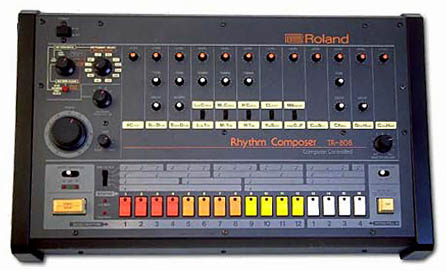
In 1980, Roland Corporation introduced the (Transistor Rhythm) TR-808 drum machine. The TR-808 produces all of its sounds with analog synthesis, generating unrealistic sound for some of the instruments. Hihat sounds within the TR-808 are produced by simply applying volume envelopes to white noise. I happen to like the TR-808 hihat sounds a lot, but in the era that this machine was released, many music producers were seeking realism. The analog-synthesized TR-808 had a tough time competing against the more expensive but now-legendary standalone sample-based drum machine of the era, the LinnDrum. Some producers who relied on sampled percussion weren't satisfied with cymbal samples, and chose to record cymbals in the studio to accompany the drum machine tracks.
Despite its rough start, the Roland TR-808 has a great history with music production and performance that continues today. One prominent example of TR-808 usage in mainstream music is Marvin Gaye's 1982 soul hit, "Sexual Healing." By the end of the 1980s, electronic music producers were seeking out the TR-808 for its deep, punchy bass drum sound.
The Roland TR-808 introduced the world to step sequencing, which enables rhythm programming without requiring a live performance in which the timing must be just right. The 16-step sequencer on the TR-808 allows the user to easily turn a sound on or off at each of the 16 steps in the sequence by simply pressing a button. Sequences can be as long as 32 steps, with steps 17-32 reusing the row of 16 buttons.
MIDI was not available in 1980, but the TR-808 includes one DINSync jack which is switchable between input and output. Three trigger outputs are also included, utilizing the cowbell, clap, and accent sequences. These trigger signals would control the progression of a sequence that was programmed sequentially in another instrument such as a synthesizer.
One of the TR-808's features that provided an incredible amount of versatility for recording and mixing was individual outputs for each sound. This allows any individual instrument to be processed differently from the main mix.
Here's one of my favorite Roland TR-808 videos on YouTube, in which several music producers describe this drum machine's allure:
No comments:
Post a Comment